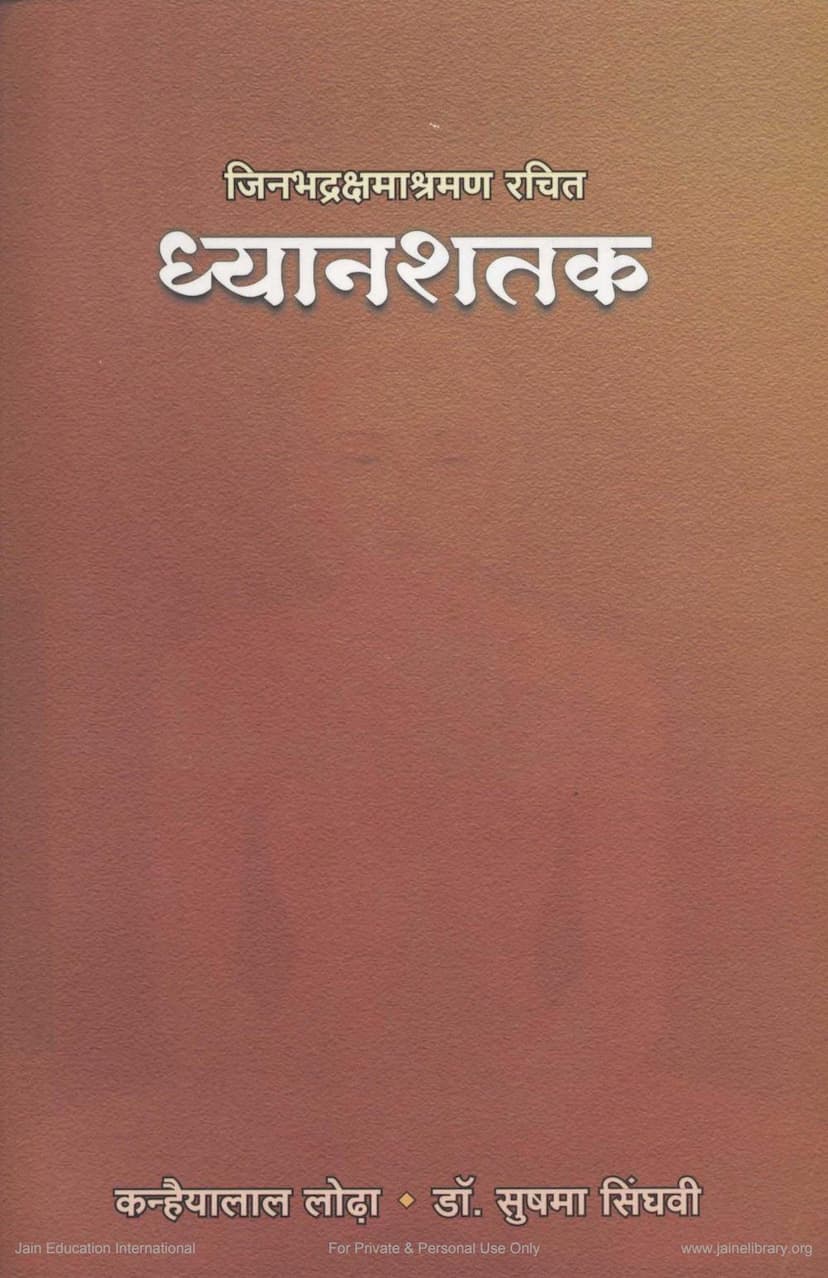Dhyanashatak
Added to library: September 1, 2025

Summary
This document is the Prakrit Bharti Academy edition of Dhyanashatak, a significant Jain text authored by Jinbhadragani Kshamashraman. The book has been edited and commented upon by Kanhiyalal Lodha and Dr. Sushma Singhvi.
The "Prakaskiy" (Publisher's Note) section highlights the importance of Yoga and Meditation in Indian religious and philosophical traditions, including Jainism. It states that Dhyanashatak is perhaps the oldest, most independent, and well-organized work on the subject of meditation in the Jain tradition, dating back to the 6th century CE. The publisher emphasizes their commitment to promoting Jain Yoga literature and mentions previous publications in this area. They express gratitude to Kanhiyalal Lodha for his expertise in Jain and Buddhist studies and his meditation practice, and to Dr. Sushma Singhvi for her scholarly translation and introduction, as well as to Sagar Mal Jain for his scholarly foreword.
The "Bhumika" (Introduction) delves deeper into the significance of meditation in Jain practice, defining it as a practice of Samatva Yoga (equanimity yoga), which is impossible without meditation and Kayotsarga (body abandonment). It explains that external focus or attachment to worldly objects and people disturbs the mind, leading to passion (raga) and aversion (dvesha), which disrupt equanimity. The introduction clarifies that while Arta Dhyana (sorrowful meditation) and Raudra Dhyana (fierce meditation) are categorized as forms of meditation, they are to be renounced for spiritual progress. Dharma Dhyana (righteous meditation) is considered the initial stage of spiritual practice, and Shukla Dhyana (pure meditation) is the ultimate stage, transcending both good and bad, and leading to liberation. The author discusses the tradition of naming texts based on the number of verses (shatak, shataka) and argues for the authenticity of the name "Dhyana-adhyayana" given by Jinbhadragani Kshamashraman himself, while "Dhyanashatak" was given by the commentator Haribhadrasuri.
A significant portion of the introduction is dedicated to discussing the authorship of the text, attributing it to Jinbhadragani Kshamashraman, a prominent Jain Acharya of the 6th century CE. The introduction addresses scholarly debates regarding his authorship, citing textual evidence and analyzing the language and style to confirm his contribution. It also discusses the dating of the text, placing its composition within the 7th century CE, specifically the first half.
The "Granth ki Vishayavastu aur uska Vaishishtya" (Subject Matter and Uniqueness of the Text) section provides a detailed outline of Dhyanashatak's content:
- Definition of Meditation: Concentrating the mind is defined as meditation, while a wavering mind is considered "chitta" (mind).
- Four Types of Meditation: The text categorizes meditation into four types:
- Arta Dhyana (Sorrowful Meditation): Described as a cause of worldly wandering, this is further divided into four types:
- Anishta Sanyoga (Conjunction with the unpleasant)
- Viyoga Chinta (Worry about separation)
- Ishta Viyoga (Separation from the desired)
- Nidana Chintana (Wishing for future benefits)
- Raudra Dhyana (Fierce Meditation): Also a cause of worldly wandering and rebirth in hellish realms, this is divided into four types:
- Himsa-anubandhi (Related to violence)
- Mrisha-anubandhi (Related to falsehood)
- Staya-anubandhi (Related to stealing)
- Vishaya-samrakshana-anubandhi (Related to protecting worldly possessions)
- Dharma Dhyana (Righteous Meditation): This is presented as a means to liberation and is discussed extensively through twelve "dwara" (aspects or sections): Bhavana (contemplation), Desha (place), Kala (time), Asana (posture), Alambana (object of meditation), Karma (process), Dhyatavya (object to be meditated upon), Dhyata (meditator), Anupreksha (contemplation), Leshya (mental disposition), Linga (characteristics), and Phala (fruit/result). The text outlines four types of Dharma Dhyana: Ajna Vichaya (contemplation of commands), Apaya Vichaya (contemplation of defects), Vipaka Vichaya (contemplation of karma's results), and Samsthana Vichaya (contemplation of the structure of the universe).
- Shukla Dhyana (Pure Meditation): This is the highest form of meditation leading to liberation, and it is described in detail through various aspects, including its four stages: Prithaktva Vitarka Vichara (separation of thought and deliberation), Ekatva Vitarka Avichara (unity of thought and absence of deliberation), Sukshma Kriya Anivrutti (subtle cessation of activity), and Vyucchinna Kriya Apratipati (interrupted activity, non-regressing). The text discusses the characteristics of the meditator, the role of Lésya (mental disposition), and the fruits of Shukla Dhyana, which lead to the destruction of karma and eventual liberation.
- Arta Dhyana (Sorrowful Meditation): Described as a cause of worldly wandering, this is further divided into four types:
The introduction also makes a comparative analysis of Jain meditative practices with those found in Vedic and Buddhist traditions, noting similarities and unique aspects of Jain yoga. It highlights the importance of Samvitvaparikarma (preparatory practices for right faith) and the role of Anupreksha (meditative reflections) in Jain meditation.
In essence, Dhyanashatak is a comprehensive treatise on Jain meditation, systematically explaining its types, principles, practices, and its ultimate goal of liberation, all rooted in the philosophical framework of Jainism. The edition published by Prakrit Bharti Academy aims to make this valuable text accessible to a wider audience.